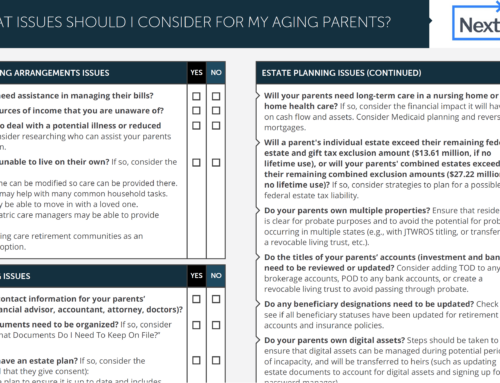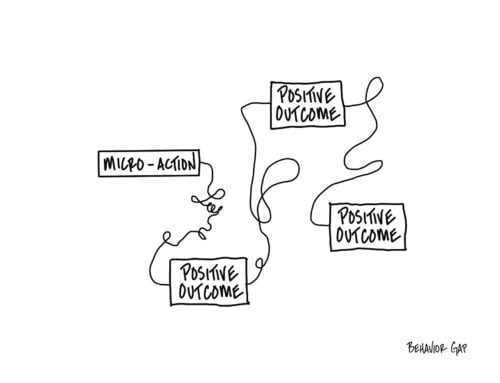In a recent post, I wrote about the 4% rule in retirement planning and it’s numerous limitations. I also said I’d write about my preferred way for planning retirement. Unfortunately, I don’t have a catchy name for it. So I’ll just describe it as goal and time-based planning to find YOUR retirement number. Basically, you want to break up that large nest egg you’ve created and give each of those dollars a job. That could be future income, inheritance, long-term care, or one of the other things I’ll describe.
Taking this approach can provide peace of mind for spending because you know you have money allocated to the other “what ifs” that can happen as we age.
Finding YOUR Number
This exercise can be done in one of two ways. The first is during your later accumulation years (think 10-15 years from retirement to get a ballpark on how much you’ll need to have at retirement for your life. The second is closer to retirement where you can actually start to make decisions based on how much you’ve saved.
So let’s dive in:
Minimum Lifestyle Expenses
The first thing you want to understand is your Minimum Lifestyle Expenses (MLE). This is the amount of income you need to cover housing, healthcare, transportation, utilities, and food.
You’ll also want to assess how much guaranteed income you’ll have coming in. These are things like a military pension, VA disability, Social Security, pension, or annuity income.
If there is a shortfall, between MLE and guaranteed income, that will be the first expense category we need to plan for. There are 2 times where this shortfall usually appears. The first is if you retire early before claiming Social Security. This is the delay period. It’s relatively easy to assess because it’s a fixed time period. The second is later in life if MLE expenses rise faster than guaranteed income or if the military spouse dies first and SBP payments aren’t enough to cover MLE.
Ensuring this is taken care of is critical to ensuring you never run out of money in retirement.
MLE Shortfall (Delay Period): __________________________
MLE Shortfall (Spousal Shortfall): __________________________
MLE Shortfall (End of Life): __________________________
Guaranteed Inheritance or Charitable Gifting
Leaving a legacy gift to family, friends, or charity is important to many people. For those with special need children or other loved ones who depend on them, it may be critical. Others say my children or charity can have whatever is left behind. If you want to identify money for this, you’ll want to make sure you set it aside.
Inheritance: ______________________
Charitable Gifting: _____________________
Bucket List / Retirement Vision / Fun Spending Beyond MLE
Most people approach retirement with at least some idea of what they want to do beyond their minimum necessities covered with MLE. It could be simply to continue their current standard of living and to add on more travel to see the grandkids. Others may have much grander plans with significant travel, second home purchase, buying an RV, or other large bucket list times. Projecting these expenses and knowing you’ve got the money to make it happen can help you psychologically deal with spending the money.
It’s also important to understand this with respect to the phases of retirement called Go-Go, Slow-Go, and No-Go because if you wait to spend the money, you may not have ability or desire to do these things later in retirement.
Retirement Fun Spending: ______________________
Long-Term Care / Aging / Buffer Funds
These three things can be thought of as one pool of funds, but I like to break them out to think about how much you might need.
Long-Term Care
Long-Term Care is one of the biggest unknowns in retirement planning. If you plan to self-fund, you’ll need to determine how much you’ll want to set aside for the potential need for care. There are many factors that can go into this calculation. These include where do you want to get the care, how long do you want to be able to pay for care, will you assume an escalating need, etc.
For most couples the most expensive time in retirement is when 1 member needs extensive care in a facility while the other one is still living in the primary residence. At that point you’re having to in effect maintain two households. Once the first passes away, all of the income and perhaps home equity could be used to pay for care.
Aging Reserve
The again reserve are funds identified to support you as you age and your physical ability or just interest in doing certain activities declines. These are usually household chores like mowing the lawn, home maintenance, house cleaning. If you plan to move to an apartment or community that takes care of some of this you may need to dedicate less money to this category.
Buffer Assets/Funds
Buffer assets or funds provide that sleep at night factor. You may have a great plan, but as Mike Tyson said “Everyone has a plan until they get punched in the mouth”. Even the best plans can have unfortunate setbacks. Having some additional funds available for whatever that might be is critical. How big this needs to be depends on what you have available to make you comfortable and how much flexibility you have within your other categories.
For some people, funds set aside for an inheritance can serve as a buffer fund. They decide that they hope to leave money to heirs or charity, but if something happens and they need additional funds they can use that. That wouldn’t work for families with special needs children or other family members that they may need to directly support. It is something to consider though if you’re
Long-Term Care: ______________________
Aging Reserve: _______________________
Buffer Funds: ______________________
I find it can often be useful to think about these 3 independently, but also holistically as a time-based need. This is especially true for Long-Term Care. The question you need to answer is how long do I want to pay for these services? If you’d like to plan based on having 5 years of coverage for nursing home care that could be used by either member of the couple and a year of care in your area is $120,000, you’d want to have $600,000. For aging reserve it could be providing $1000 per month for 10 years ($120,000) and 5 years of $3000 per month ($180,000) to try to stay in your home as long as possible.
Inflation, Investing, and Getting To That Final Number
Once you’ve done this, you’ll simply sum up the categories to get YOUR Retirement number. Not all of this money is needed on day 1 of retirement so structuring your investments appropriately can play a big part in your success. Funds needed in the near-term should be invested more in principle-protected assets like money markets and savings accounts. Funds that aren’t needed for 5 or more years can be invested in longer duration assets like stocks and bonds.
It’s also important to factor in inflation when doing this exercise. Costs as we’ve seen recently can go up significantly. Your expenses for things 20 years in the future can have a wide range of possible outcomes.
This article is meant to give you a ballpark understanding of how I like to think about retirement readiness, but it’s certainly not the only option. If you’d like to set up a call to talk about building your plan, I’ve got a few more spots for new clients before the end of the year. You can set up a call here (link).



